|
Getting your Trinity Audio player ready...
|
Today, we will be talking about Yoast SEO, but first…
Imagine!
The SEO world is a big, colorful, vegetable garden, where as we all know, each plant needs different care to grow strong and give us a good harvest.
Keep thinking this way.
Just like some vegetables prefer sunlight and more work than the others that prefer shade, just like that various aspects of SEO require different strategies and tools to succeed and give us THE results.
My name is Hristijan, your SEO buddy, and today I want to share with you a useful tool
( at least works for me ) on how to boost your WordPress website’s visibility on search engines.
So, let’s get started!
Tools like Yoast SEO, All in One SEO Pack, and SEOPress empower users to optimize their content for search engines, streamline their site’s performance, and improve user experience.
However, different tools address unique aspects of SEO, for instance, while one may excel in keyword optimization, another might focus on technical SEO or link building.
Tadaam, Yoast SEO ( the cliche of thank me later )
Yoast SEO WordPress is one of the best tools for boosting your WordPress website’s visibility on search engines.
With millions of active installations, it simplifies the complex aspects of search engine optimization (SEO).
We will take you through everything you need about setting up and configuring Yoast SEO, using the content analysis feature to optimize posts, and diving into its advanced settings like schema markup and breadcrumbs.
Why Yoast SEO is Crucial for WordPress Sites
Simple, WordPress SEO plugin enhances driving organic traffic to your website.
Without optimizing my site for search engines like Google, my content may never reach the right audience.
In fact, according to a study by BrightEdge, 68% of all online experiences start with a search engine.
Yoast SEO makes WordPress SEO plugin accessible to everyone, whether you’re a beginner or a seasoned pro, ensuring your content ranks better and is more discoverable.
How Can I Set Up and Configure Yoast SEO?
To set up and configure Yoast SEO, follow these steps:
Setting up
Yoast SEO is the first step to getting your WordPress site optimized for search engines. Let’s walk through the process step by step.
Step 1: Installing Yoast SEO
1. Log in to your WordPress dashboard.
2. Go to the “Plugins” section and click “Add New.”

3. Search for “Yoast SEO” in the search bar.

4. Click “Install Now” wait for a few moments and then “Activate.”

Step 2: Using the Configuration Wizard
Once activated, Yoast SEO prompts you to configure it using the setup wizard.
You can find the Yoast Settings in the menu on the left.
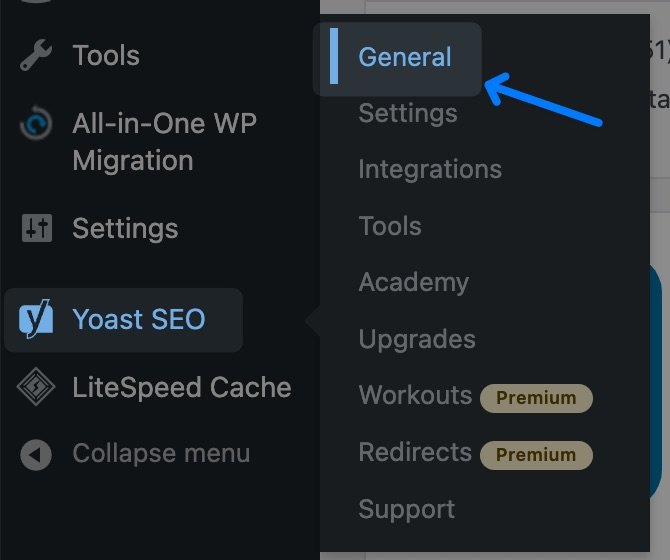
The wizard makes it easy to tailor Yoast SEO to your specific site by walking you through several steps:
- Website Type: Choose the type of website you’re running; whether it’s a blog, online store, or portfolio.
- Search Engine Visibility: Select which pages should be indexed by search engines. For example, it’s often unnecessary to index login pages or other internal sections.
- Multiple Authors: If your site has multiple authors, you’ll want to specify this in the setup so that author-specific pages are created and indexed.
Completing the setup wizard ensures that Yoast SEO is optimized for your site’s unique needs from the get-go.

Optimizing Posts and Pages with Yoast’s Content Analysis
Once Yoast SEO is set up, it becomes your SEO assistant for every post and page you create. Which is great!
The content analysis feature is one of Yoast’s most powerful tools, offering real-time feedback on how well your content is optimized.
Step 1: Focus Keyphrase
Every post or page should target a specific focus keyphrase. This key phrase is what you want your content to rank for in search engines.
In Yoast SEO, you can set a Focus Keyphrase in the Yoast Meta Box, which appears below your WordPress editor.
For example, if you’re writing a blog about “best coffee brewing methods,” that phrase would be your focus keyphrase.
Yoast SEO will then analyze your content to ensure you’ve used the keyphrase enough times in important places like the optimized SEO titles, meta descriptions, headings, and body text.
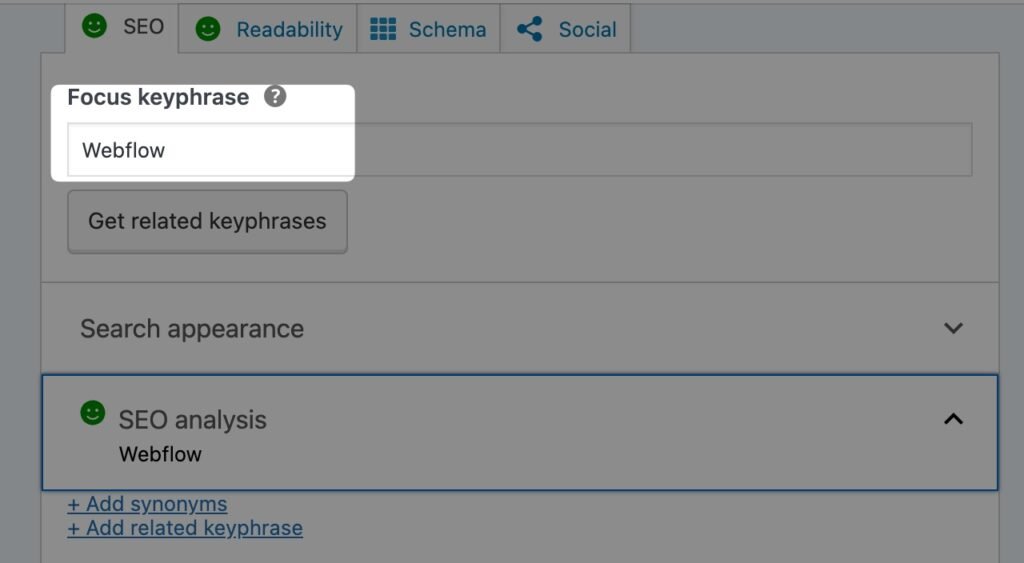
Step 2: SEO Analysis
Once you enter your focus keyphrase, Yoast SEO’s analysis tool runs through your content and provides feedback on how to improve it.
It checks for:
- Keyphrase Density: How often you’ve used the keyphrase in the text. Too few or too many uses can negatively impact your ranking.
- Titles and Meta Descriptions: The meta description is what shows up in search results. Including your keyphrase here can improve your click-through rate.
- Outbound Links: Linking to external sites boosts your WordPress SEO plugin because it shows search engines that your content is well-researched.
- Image Alt Text: Adding alt text that includes your keyphrase to your images helps optimize for Google Image Search.
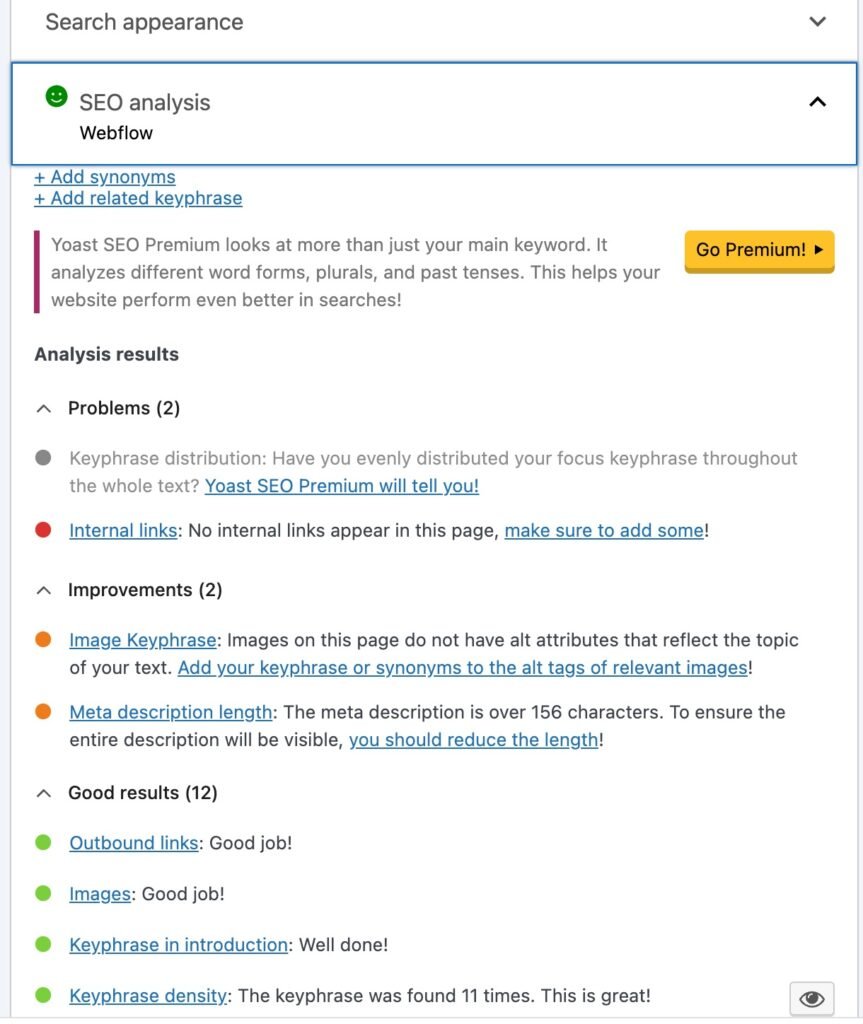
Step 3: Readability Analysis
Yoast SEO also provides a readability analysis to ensure your content is easy to read. This feature checks:
- Sentence Length: Shorter sentences are easier to digest and keep readers engaged.
- Paragraph Length: Long paragraphs can overwhelm readers, so Yoast suggests breaking them up.
- Passive Voice: Active voice is clearer and more direct, which makes your content easier to read.
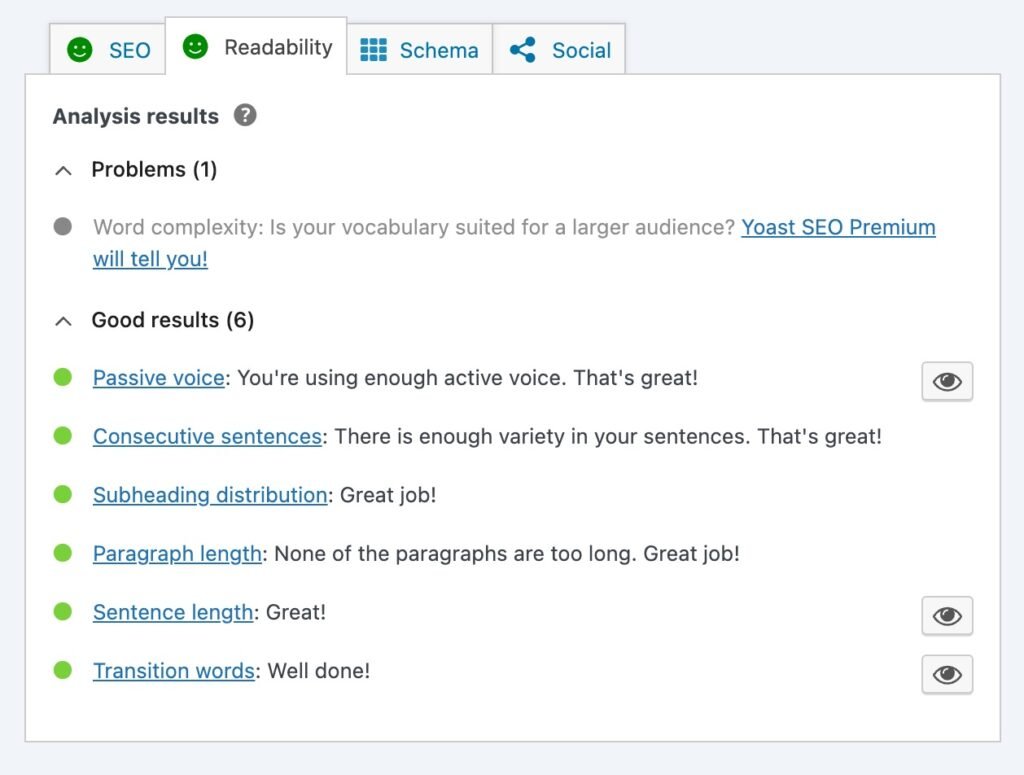
According to a study by the Nielsen Norman Group, users typically read only 20-28% of words on a page.
Therefore, having well-structured and readable content is key to keeping visitors on your site longer. Keep your visitors coming back for more.
As they say in The Godfather “Leave the gun, take the cannoli”. In this case, leave the confusion behind and take clear, engaging content!
Feel free to reach out to us (email here) if you have any questions or if you are just feeling a bit lost.
It’s fine.
Advanced Features of Yoast SEO WordPress
While the basic setup and content analysis features of Yoast SEO are powerful, its advanced features can take your WordPress SEO plugin to the next level.
Schema Markup
Schema markup is code that helps search engines understand the context of your content.
Yoast SEO automatically adds schema to your posts, marking them as articles, products, or other types of content.
This structured data helps search engines like Google better understand your site, which can improve your chances of appearing in rich snippets, as well as the additional information you see in some search results, like star ratings or product prices.
For example, if you’re running a recipe blog, schema markup can help search engines display your recipe’s cooking time, ingredients, and reviews directly in search results, making your post more likely to stand out.
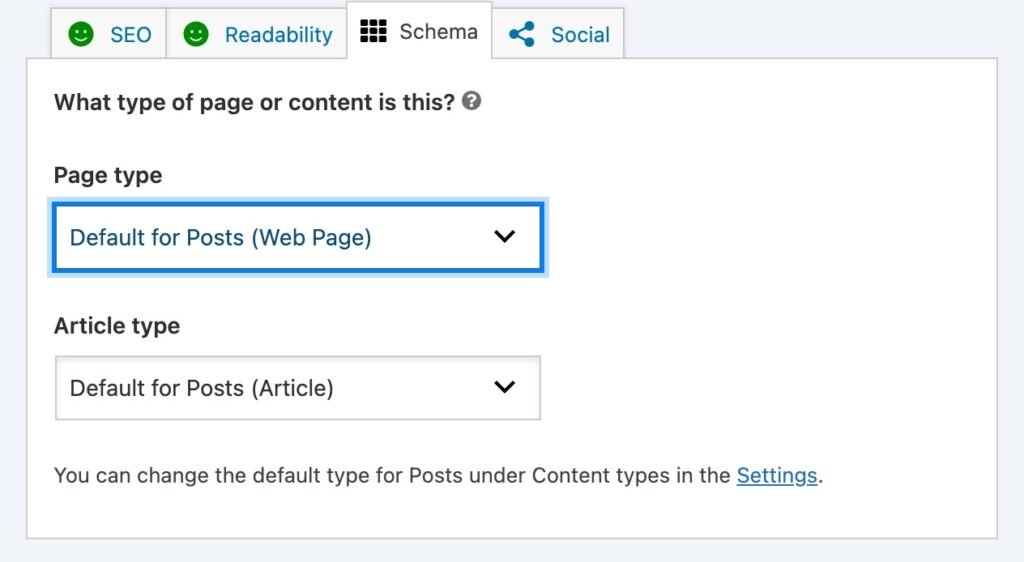
Breadcrumbs
Breadcrumbs are navigational elements that help users (and search engines) understand where they are on your site.
They also improve your internal linking structure, which is a key WordPress SEO plugin ranking factor. Yoast SEO makes it easy to add breadcrumbs to your site with just a few clicks.
To enable breadcrumbs:
- Go to the “SEO” tab in your WordPress dashboard.
- Click on “Search Appearance.”
- Navigate to the “Breadcrumbs” section and toggle them on.
Not only do breadcrumbs improve user experience, but they also enhance your site’s crawlability, making it easier for search engines to understand your site’s hierarchy.

Social Settings
Yoast SEO lets you control how your content appears when shared on social media platforms like Facebook and Twitter.
This is important because social shares can indirectly boost your WordPress SEO plugin through increased traffic.
To configure social settings:
- In the Yoast Meta Box, when you are editing the page at the bottom, go to navigate to the “Social” tab.
- Set a custom image, title, and description for when your content is shared on social platforms.
This feature ensures that your posts look appealing when shared, encouraging more clicks and shares.
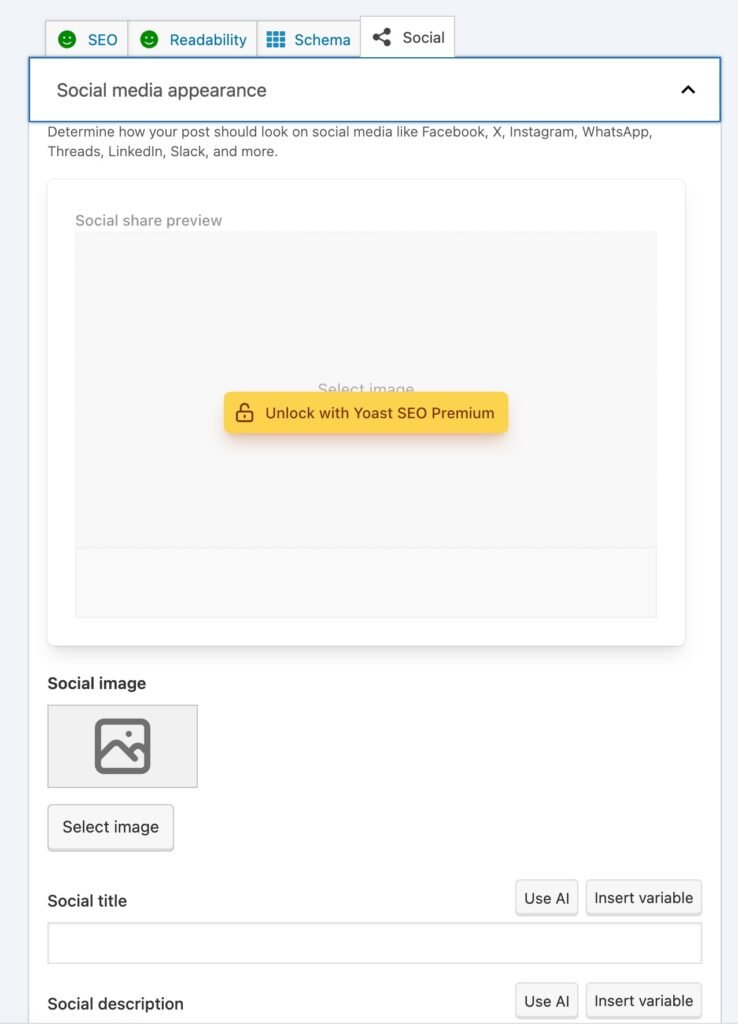
Pro Tips for Getting the Most Out of Yoast SEO
To fully unlock the potential of Yoast SEO, here are some additional tips:
1. Use Internal Linking
Linking to other relevant posts on your site helps keep visitors engaged and improves your WordPress SEO.
Yoast SEO Premium even offers internal linking suggestions to make this easier.
2. Optimize for Mobile
As of 2021, over 54% of global website traffic comes from mobile devices (Statista).
Yoast SEO can help ensure your content is mobile-friendly by providing a mobile preview feature in its SEO analysis.
3. Update Old Content
Google loves fresh content. Use Yoast SEO to keep your cornerstone content and your most important articles updated.
This helps maintain your site’s authority and relevance.
4. Avoid Keyword Stuffing
While Yoast SEO encourages the use of your focus keyphrase, overusing it can hurt your rankings.
Aim for a natural flow rather than forcing keywords into every sentence.
Comparison: Yoast SEO Free vs. Premium
| Feature | Yoast SEO Free | Yoast SEO Premium |
| Focus Keyphrase | Single keyphrase | Multiple keyphrases |
| Redirect Manager | No | Yes |
| Internal Linking Suggestions | No | Yes |
| Social Previews | Yes | Yes (with customization) |
| 24/7 Support | No | Yes |
| Ads-Free | No | Yes |
While the free version of Yoast SEO offers powerful features, the Yoast SEO premium version provides additional functionality like multiple keyphrases per post, a redirect manager, and more robust internal linking suggestions.
If you’re managing a large site with many pages, upgrading to premium may be worth the investment.
Common Pitfalls and How to Avoid Them
Even with a highly efficient tool like Yoast SEO, it’s easy to make mistakes that can hurt your site’s performance.
Let’s look at some of the most common WordPress SEO pitfalls and how you can avoid them to get the best results from your efforts.
1. Over-Optimization
It’s natural to want your content to rank well, so you might feel tempted to stuff your focus keyphrase everywhere in your post.
While it may seem like more is better, over-optimization can actually harm your rankings.
This is known as “keyword stuffing,” and Google’s algorithm is smart enough to detect it.
Instead of overloading your text with the same keyphrase, aim for natural usage.
Try using variations of the keyphrase (known as LSI keywords), and focus on writing content that is useful and flows well for readers.
Google is more likely to reward content that provides real value rather than something clearly stuffed with keywords.
How to Avoid Over-Optimization
Remember this 2,
- Stick to a natural flow:
Write like you’re explaining something to a friend.
Use your keyphrase naturally, and avoid forcing it into every sentence.
- Use synonyms and related terms:
Throw in variations of your keyword.
This helps with SEO and makes the content sound more natural.
For example, if your focus keyword is “best-running shoes” also use related terms like “top shoes for running” or “running shoes for him”
2. Readability
SEO is important but so is user experience. One of the biggest mistakes people make is focusing too much on technical SEO and forgetting about how readable their content is.
If your article is filled with long sentences or huge blocks of text people will get frustrated and leave your page fast.
This increases bounce rates which is a signal to search engines that your content isn’t engaging or useful.
In fact, studies show the average human attention span is 8 seconds. So if your content is hard to read or overwhelming visitors won’t stick around.
How to Avoid Ignoring Readability
- Break up your text: Use shorter paragraphs, headings and bullet points to break up the content and make it skimmable.
- Use simple language: Don’t use jargon unless your audience is highly technical. Use language that’s easy to understand and to the point.
- Short sentences: Limit your sentence length. Aim for 20 words or less per sentence.
Yoast SEO has a built-in Readability Analysis that checks for these things and gives you suggestions so use that as a guide!
3. Ignoring Meta Descriptions
Another big mistake is ignoring your titles and meta descriptions.
This is the short snippet that shows up under your page title in search engine results and plays a big role in whether users click on your link or not.
It doesn’t affect rankings but a well-written meta description can increase click-through rates (CTR).
If more people click on your link it’s a good signal to Google that your content is relevant which can eventually improve rankings.
Too many people forget about this small but important detail or leave it blank.
When this happens Google will automatically generate a meta description from your page’s content which may not be as good as something you write yourself.
How to Avoid Neglecting Meta Descriptions
- Be brief but descriptive: You have about 150-160 characters to describe what your page is about. Use every word wisely.
- Use action verbs: Verbs like “discover”, “learn” or “find out” create a sense of urgency and encourage users to click.
- Include your focus keyword: If possible work your keyword into the meta description naturally to catch both user and algorithm attention.
For example: “We sell running shoes.” “Find running shoes for him.” “Free shipping.”
Conclusion
In my experience, the Yoast SEO WordPress plugin is the simplest way to boost your site’s rankings. Just an honest review!
From keyphrase optimization and readability to schema markup and social previews, Yoast SEO has it all.
With millions of sites using it to boost their SEO Yoast SEO is the most powerful tool for WordPress users.
Follow this guide and you’ll be on your way to more visibility, more traffic, and a bigger audience.
Now, thank you for getting until the end.
Here is a picture of me in front of a Yoast booth on one of the greatest SEMRUSH events in Amsterdam.

Let us know if you’re working on something right now, and we can take a look at it together! Reach out at davor@antibe.co ( after 6 PM CET).
Frequently Asked Questions
What is Yoast SEO in WordPress?
Yoast SEO is a plugin for WordPress users to get their site SEO better.
It makes optimizing your site for search engines like Google easier for people to find your content.
The Yoast SEO plugin has tools and features to help you improve the technical side of your site (sitemaps and breadcrumbs) and the content itself (keywords, readability and more).
Some of the features:
- SEO Analysis: Check if your content is optimized for keyphrases.
- Readability Analysis: Check if your content is readable by visitors.
- Social Media Integration: This feature helps you optimize how your content looks when shared on social media so that it integrates with Yoast SEO.
- Schema Markup: Helps search engines understand and display your content in search results.
In short: Yoast SEO covers all your SEO bases from technical setup to content optimization all in your WordPress dashboard.
Is Yoast good?
Yes Yoast SEO is considered one of the best SEO tools for WordPress sites.
It’s easy to use even for beginners and has a ton of features to improve your site’s SEO.
Here’s why Yoast SEO is good:
- User Friendly: The interface is designed to be simple so SEO is more accessible to non-experts.
- Comprehensive Analysis: The Yoast SEO plugin checks your content for keyphrases, readability and technical SEO issues like titles and meta descriptions and link building.
- Regular Updates: Yoast SEO is updated regularly to keep up with Google’s algorithm changes so your site stays optimized for search.
- Community Support: Yoast has a huge user base and tons of resources (including tutorials) to help you get the most out of the Yoast SEO plugin.
Its combination of technical and on-page SEO features makes it a well-rounded tool for any WordPress site owner looking to boost their rankings.
Can I use Yoast SEO for free?
Yes, Yoast SEO has a free version which has many essential SEO tools. The free version has:
- Focus Keyphrase: Optimize each page or post for one keyphrase.
- Content and Yoast SEO Analysis: Adjust your content to SEO and readability standards.
- XML Sitemaps: Generates and updates your sitemaps automatically, so search engines can index your site faster.
But Yoast SEO also has a premium version which has:
- Multiple Focus Keyphrases: Optimize a post for more than one keyphrase.
- Redirect Manager: Manage 301 redirects when you change URLs, so you don’t lose SEO.
- Internal Linking Suggestions: Suggests related content to link within your site, so users and search engines love you more.
The free version is good enough for basic and technical SEO needs, but if you’re managing a bigger site or need more advanced tools, you might want to upgrade to the premium version.
How to install Yoast SEO for WordPress?
- Install the Yoast SEO Plugin:
- Log in to your WordPress dashboard.
- Go to “Plugins” > “Add New.”
- Search for “Yoast SEO” and click “Install Now,” then “Activate.”
- Configuration Wizard:
- After activation, you will be asked to run the Configuration Wizard.
- The wizard will guide you through the essential settings:
- WordPress Website Type: Choose if your site is a blog, e-commerce site or something else.
- Search Engine Visibility: Decide which part of your site you want search engines to index (e.g. posts, pages, tags).
- Multiple Authors: If you have multiple authors on your site, Yoast can create individual author archives.
- Optimize Your First Post:
- Once set up you will see the Yoast SEO meta box below the WordPress block editor on each page or post.
- Add a focus keyphrase and Yoast will analyze your content to make sure it’s SEO-friendly and will give you suggestions to improve.
By following these steps, you’ll ensure your site is optimized from the start and ready for better search engine visibility.
